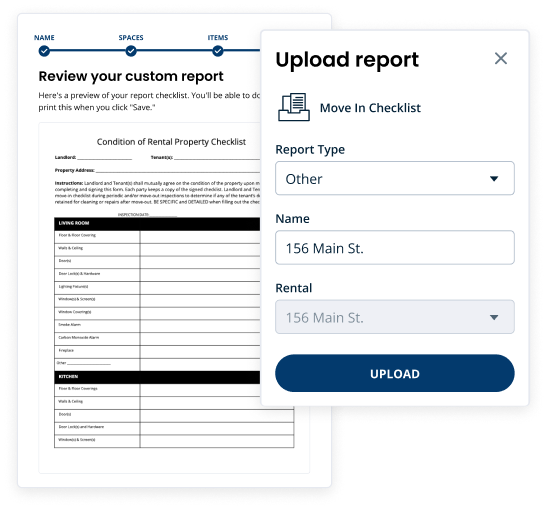12 min read
Real Estate Accounting 101: Everything Landlords Must Know
Real estate accounting is an essential part of running a rental property business, no matter the size of your portfolio. Whether you...

A move-out checklist condition report is essential for landlords to document a rental’s condition once a tenant vacates.
Picture this: Upon your final walkthrough of a rental property, your tenant insists he left the place spotless, but your inspection tells a different story: rotten meat in the fridge, deep scrapes on the countertop, and the dirtiest toilet you’ve ever seen in your life.
Thankfully, you used TurboTenant’s free digital move-out checklist to document the damage carefully. And, when you cross-reference it with the move-in checklist he filled out a year ago, you can identify the exact damage from his tenancy and hold him accountable.
Without using property management software to generate a move-out checklist, you wouldn’t have been able to document the damage your tenant caused. He could have disputed your deductions, claimed pre-existing damage, and taken you to court (like he did with his old boss).
Keep reading to learn when to issue a move-out checklist, what areas to inspect, and how a free digital condition report can protect your rental property from nightmare tenants.
Customize your condition report. Send it to your tenants for e-signatures. Store it in your TurboTenant account to reuse and reference during move outs.
Customize your condition report. Send it to your tenants for e-signatures. Store it in your TurboTenant account to reuse and reference during move outs.
A move-out checklist helps landlords assess a property’s condition after a tenant moves out of their rental unit. By documenting damage beyond normal wear and tear, landlords have ground to stand on while making security deposit deductions.
By comparing a move-out checklist to the move-in condition report that a tenant filled out when moving in, landlords can quickly identify any damage that occurred during the tenancy and make deductions accordingly.
Security deposit disputes between landlords and renters are common, with tenants often claiming that certain deductions are unfair. A move-out checklist gives landlords a way to provide clear documentation of damage, justify deductions, and avoid messy conflicts.
If landlords don’t utilize a move-out condition report, they risk finding themselves in time-consuming disputes with tenants or paying for tenant damage themselves. “He said, she said,” quarrels are common when landlording but can easily be avoided with condition reports.
In an effort to increase transparency, 17 states legally require landlords to conduct them before making security deposit deductions. But, regardless of whether or not your state requires you to, using a move-out checklist is the right move.
While the earlier scenario protected you from a reckless tenant, a move-out checklist would have protected him if you couldn’t justify your deductions. Like lease agreements, these condition reports protect landlords and tenants.
Some states require landlords to issue a move-out checklist before withholding any portion of a tenant’s security deposit. Providing this documentation helps ensure compliance with state laws and prevents disputes.
The following states mandate that landlords issue move-in and move-out condition reports:
While the above states enforce laws regarding move-in and move-out condition reports, specific regulations vary from state to state. For example, some states only require condition reports if a landlord collects a security deposit from a tenant.
For landlords who live in states without these regulations, issuing move-in and move-out condition reports is still wise. Doing so will detail the rental’s condition, foster a trustworthy relationship between landlord and tenant, and prevent squabbles over deductions.
Completing a move-out checklist as soon as possible after a tenant vacates helps avoid any unnecessary disputes. The longer you wait to perform a walkthrough, the harder it will become to prove when the damage occurred, leaving room for needless conflict.
You can approach them in a few ways. Some tenants want to participate in the move-out inspection, while others trust landlords to handle it alone. Either way, accuracy, honesty, and thorough documentation are key during the move-out process.

To prevent disputes, landlords and tenants should be exhaustive when completing and reviewing move-out checklists. To do so, focus on inspecting the following areas during move-out walkthroughs:
Flooring and carpets: Check hardwood, laminate, tile, and vinyl floors for stains, cracks, or dents. Examine carpets for discoloration, fraying, moisture buildup, or deep-set stains.
Walls and ceilings: Inspect walls and ceilings for scuff marks, cracks, tenant paint jobs, or water stains that may indicate leaks. Look for holes left by nails, screws, or wall anchors from previous tenants.
Doors: Ensure doors open and close without sticking or creaking. Test locks, doorknobs, and handles. For sliding doors, check that the tracks are clean and that the doors glide smoothly.
Windows: Ensure all windows open and close properly, and verify that locks work. Inspect for cracked glass, condensation between panes, and missing or damaged screens.
Countertops: Check countertops for stains, cracks, burn marks, or water damage, especially near sinks and dishwashers where moisture exposure is high.
Lighting and fixtures: Test all light fixtures to ensure responsive switches and bulbs work. Look for burnt-out bulbs, missing covers, or loose wiring that causes flickering. Check ceiling fan lights, as well.
Appliances: Test all major appliances, including the stove, oven, refrigerator, dishwasher, microwave, and washer/dryer. Ensure they function and check for significant damage. Run the garbage disposal to confirm it works.
Plumbing: Turn on showers, faucets, and drains to check for leaks, low water pressure, or clogs. Look for signs of mold, loose pipes, or water damage. Flush toilets to ensure they function correctly and the water stops running after the tank fills.
Electrical: Use a phone charger to test outlets and confirm they provide power. Check for missing outlet covers, exposed wiring, or burn marks. Ensure all light switches work. Verify that smoke and carbon monoxide detectors operate correctly and have new batteries.
Exterior: Inspect balconies, patios, and entryways for scuffs, scraped paint, adhesive residue, or other damage. Ensure all exterior doors open and close properly, and that locks work.
Properly conducting a fair and thorough move-out condition report is non-negotiable. Here’s the step-by-step process we recommend to conduct your move-out condition report as smoothly as possible:
Some tenants prefer to walk through their old rental unit with their landlords as they fill out the move-out condition report. Doing so will allow them to explain property damage, make in-person disputes, and discuss potential deductions with landlords.
Other tenants may not want to participate in a walkthrough, allowing landlords to complete the report without them. In this event, perform the walkthrough as soon as possible after their move-out date to avoid any potential back-and-forth as to when the damage occurred.
Take high-quality photos, record a video walkthrough, and describe any damage in writing. Doing so will support any security deposit deductions you need to make. To ensure your condition report is secure, utilize a digital cloud-based move-out checklist.
Compare the move-out condition report against the tenant’s original move-in checklist, look for discrepancies, and document any notable damage. By cross-referencing the two reports, you can ensure you don’t accidentally charge tenants for pre-existing damage.
Determine damage caused during a tenancy that exceeds normal wear and tear. Minor scuffs and dings are expected, but broken appliances, deer hide lodged in a garbage disposal, or cracked windows may warrant repair costs deducted from a tenant’s security deposit.
Decide whether you want to handle upcoming repairs yourself or hire a contractor to perform them for you. As you work on fixing the rental unit, keep receipts and invoices and document all work conducted to bring the property back to its original, rentable state.
With receipts and documentation in hand, deduct the appropriate repair amount from the tenant’s security deposit. If costs exceed the deposit, bill the tenant at their forwarding address.
If any portion of a tenant’s security deposit remains, return it promptly, along with an itemized list of deductions. Provide copies of receipts, invoices, and work orders to reduce the likelihood of a dispute.
Legal note: Check your state’s laws regarding deposit deductions and returns to ensure you meet deadlines and fulfill your legal requirements as a landlord.
Provide the tenant with a detailed copy of the move-out report, including photos, videos, and written descriptions. Sharing this information with a tenant will help them understand the deductions you made and reduce the likelihood they raise any disputes.
Our free move-out checklists will help protect you from tenants who damage your property and cry foul when you deduct expenses from their security deposit to perform repairs.
These digital move-in and move-out condition reports can help you:
Sign up for a TurboTenant account today to inspect our DIY landlord software for free.
Beyond offering customizable condition checklists, our powerful property management software helps landlords like you by:
A move-out checklist helps landlords document a rental unit’s condition after a tenant vacates, allowing landlords to compare the property’s current condition to the move-in report. Further, move-out condition reports support security deposit deductions and minimize the likelihood of disputes between landlords and tenants.
Here is the 8-step process to follow when conducting the move-out inspection process:
First, document all damages caused during a tenancy with photos, videos, and written descriptions. Next, perform repairs that return a rental unit to its previous condition. Be sure to keep records of all receipts, invoices, and work orders.
After that, deduct all associated costs from the tenant’s security deposit and provide them with an itemized statement detailing the charges. Lastly, return any remaining security deposit amount to the tenant within the timeframe required by your state’s laws.
Ideally, a landlord will complete a move-out condition report within 24 to 48 hours after the tenant vacates the rental property, which should be adequate time to conduct a thorough inspection, documentation, and assessment of damages caused during a tenancy.
12 min read
Real estate accounting is an essential part of running a rental property business, no matter the size of your portfolio. Whether you...
6 min read
Understanding the Needs of Small and Independent Landlords Managing rentals isn’t your full-time job. If you’re a small or DIY landlord, you’re...
4 min read
The Modern Landlord’s Challenge Managing rental properties no longer means living down the street from every unit. Today’s landlords often juggle multiple rental...
Join the 750,000+ independent landlords who rely on TurboTenant to create welcoming rental experiences.
No tricks or trials to worry about. So what’s the harm? Try it today!
TurboTenant, Inc., © 2025
Created in Sunny Colorado